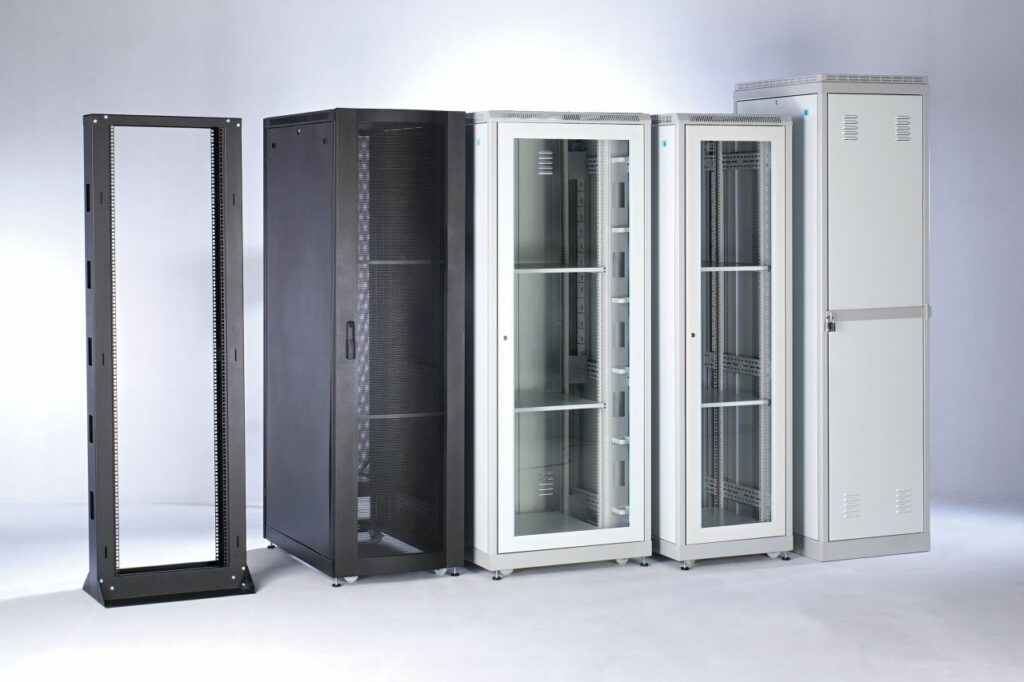People often ask, what are the benefits and drawbacks of using Open Frame vs Enclosed Server Rack Cabinets
Server rack cabinets are essential components of any data center or server room. They provide a secure and organized space to store servers, networking equipment, and other devices. When it comes to server rack cabinets, there are two main types to consider: open-frame and enclosed.
Open Frame Server Rack Cabinets
Open-frame server rack cabinets are exactly what they sound like: a frame with no doors or side panels. This type of cabinet is often used in situations where security is not a major concern, or where equipment needs to be easily accessible for maintenance or upgrades.
Benefits of Open Frame Server Rack Cabinets
- Improved airflow: Open-frame server rack cabinets allow for better airflow, which can help keep equipment cool and prevent overheating. This is especially important for high-density installations or environments with limited cooling capabilities.
- Cost-effective: Open-frame server rack cabinets are often less expensive than their enclosed counterparts, making them a popular choice for small businesses or organizations with limited budgets.
- Easy access: With no doors or side panels to navigate, open-frame server rack cabinets provide easy access to equipment, making maintenance and upgrades a breeze.
Drawbacks of Open Frame Server Rack Cabinets
- Security risks: Since open-frame server rack cabinets have no doors or side panels, equipment is more vulnerable to theft or tampering. This makes them a less ideal choice for situations where security is a concern.
- Dust and debris: Open-frame server rack cabinets can allow dust and other debris to enter the cabinet and potentially damage equipment. This can be mitigated with regular cleaning and maintenance.
Enclosed Server Rack Cabinets
Enclosed server rack cabinets, on the other hand, have doors and side panels that provide an extra layer of security and protection for equipment. This type of cabinet is often used in situations where security is a major concern, or where equipment needs to be protected from environmental factors like dust, moisture, or temperature fluctuations.
Benefits of Enclosed Server Rack Cabinets
- Enhanced security: With doors and side panels, enclosed server rack cabinets provide better protection against theft or tampering.
- Improved environmental control: Enclosed server rack cabinets can help maintain a controlled environment inside the cabinet, protecting equipment from dust, moisture, and temperature fluctuations.
- Aesthetically pleasing: Enclosed server rack cabinets have a more finished appearance, which can be important in situations where the cabinet will be visible to clients or customers.
Drawbacks of Enclosed Server Rack Cabinets
- Limited airflow: Enclosed server rack cabinets can restrict airflow, which can lead to overheating if not properly managed.
- Higher cost: Enclosed server rack cabinets are often more expensive than open-frame cabinets, which can be a barrier for small businesses or organizations with limited budgets.
- More difficult maintenance: With doors and side panels to navigate, enclosed server rack cabinets can make maintenance and upgrades more difficult and time-consuming.
Conclusion
When it comes to choosing between open-frame and enclosed server rack cabinets, there is no one-size-fits-all solution. It ultimately comes down to your specific needs and priorities. Open-frame cabinets are a great choice for situations where cost, airflow, and easy access are important, while enclosed cabinets are better suited for situations where security and environmental control are a concern. Whichever type of cabinet you choose, be sure to properly manage airflow, regularly clean and maintain the equipment inside, and take steps to ensure the security of your valuable data and equipment.

